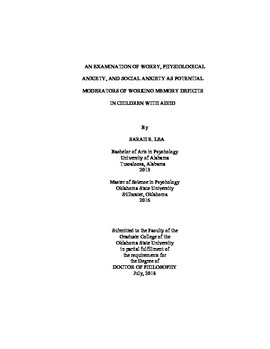| dc.contributor.advisor | Alderson, R. Matt | |
| dc.contributor.author | Lea, Sarah Elizabeth | |
| dc.date.accessioned | 2019-03-22T18:57:10Z | |
| dc.date.available | 2019-03-22T18:57:10Z | |
| dc.date.issued | 2018-07 | |
| dc.identifier.uri | https://hdl.handle.net/11244/317660 | |
| dc.description.abstract | Attention Deficit/Hyperactivity Disorder (ADHD) is a pervasive, multifaceted, and complex neurocognitive disorder characterized by problems with inattention, hyperactivity, and impulsivity that effects 3 to 7% of children worldwide. The functional working memory (WM) model of ADHD suggests that WM deficits are a core feature of the disorder, and is supported by extant findings of large-magnitude ADHD-related WM deficits. WM deficits are not unique to ADHD, however, as they have be associated with other problems of psychopathology such as general anxiety and social anxiety. Given extensive literature that has found multiple deficits in WM associated with ADHD and anxiety, and the high comorbidity of anxiety in children affected with ADHD, there has been an increased interest in determining if individuals with comorbid ADHD and anxiety symptoms experience neurocognitive deficits above and beyond deficits exhibited by children with ADHD alone. However, findings from studies examining children with comorbid ADHD and anxiety have yet to yield a clear understanding of how the relationship between ADHD and various anxiety symptom clusters affect WM performance. Although initial studies have failed to detect more severe WM deficits in children with comorbid ADHD and anxiety compared to children with ADHD alone, limitations in the measurement of WM in the studies may have failed to capture the potential "additive effect" of this comorbidity. Furthermore, the use of broadband anxiety measures may mask the effects of specific anxiety symptoms on WM. This study aimed to examine if high levels of self-reported anxiety moderate PH-WM performance differences between children with ADHD and their typically developing peers. Moreover, this study addresses limitations of previous studies by utilizing (1) a PH-WM task (i.e., Letter-Number Sequencing subtest of the WISC-IV) that is expected to place higher demands on CE functioning, (2) children's self-reported anxiety levels in lieu of parent and teacher scales that are expected to more accurately measure internal distress, and (3) three unique self-report scales of anxiety: worry, physiological anxiety, and social anxiety. | |
| dc.format | application/pdf | |
| dc.language | en_US | |
| dc.rights | Copyright is held by the author who has granted the Oklahoma State University Library the non-exclusive right to share this material in its institutional repository. Contact Digital Library Services at lib-dls@okstate.edu or 405-744-9161 for the permission policy on the use, reproduction or distribution of this material. | |
| dc.title | Examination of worry, physiological anxiety, and social anxiety as potential moderators of working memory deficits in children with ADHD | |
| dc.contributor.committeeMember | Grant, DeMond M. | |
| dc.contributor.committeeMember | Ciciolla, Lucia | |
| dc.contributor.committeeMember | Henry, Carolyn S. | |
| osu.filename | Lea_okstate_0664D_15427.pdf | |
| osu.accesstype | Open Access | |
| dc.type.genre | Dissertation | |
| dc.type.material | Text | |
| thesis.degree.discipline | Psychology | |
| thesis.degree.grantor | Oklahoma State University | |
